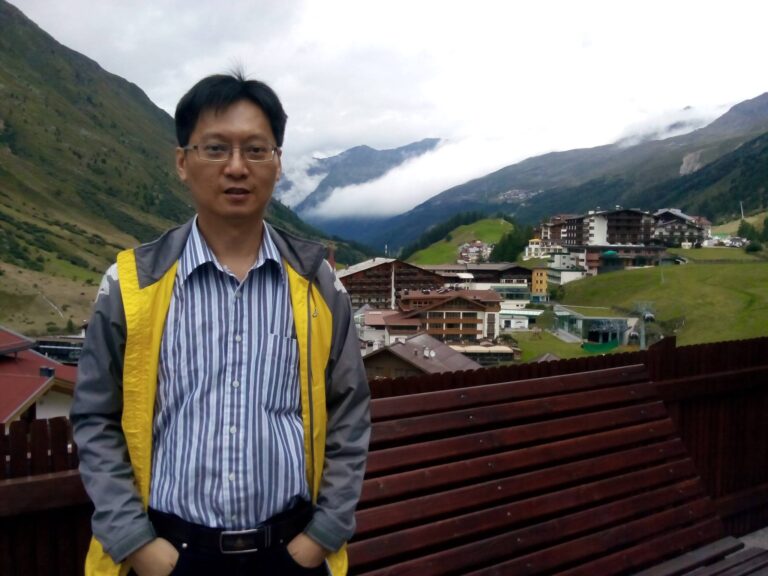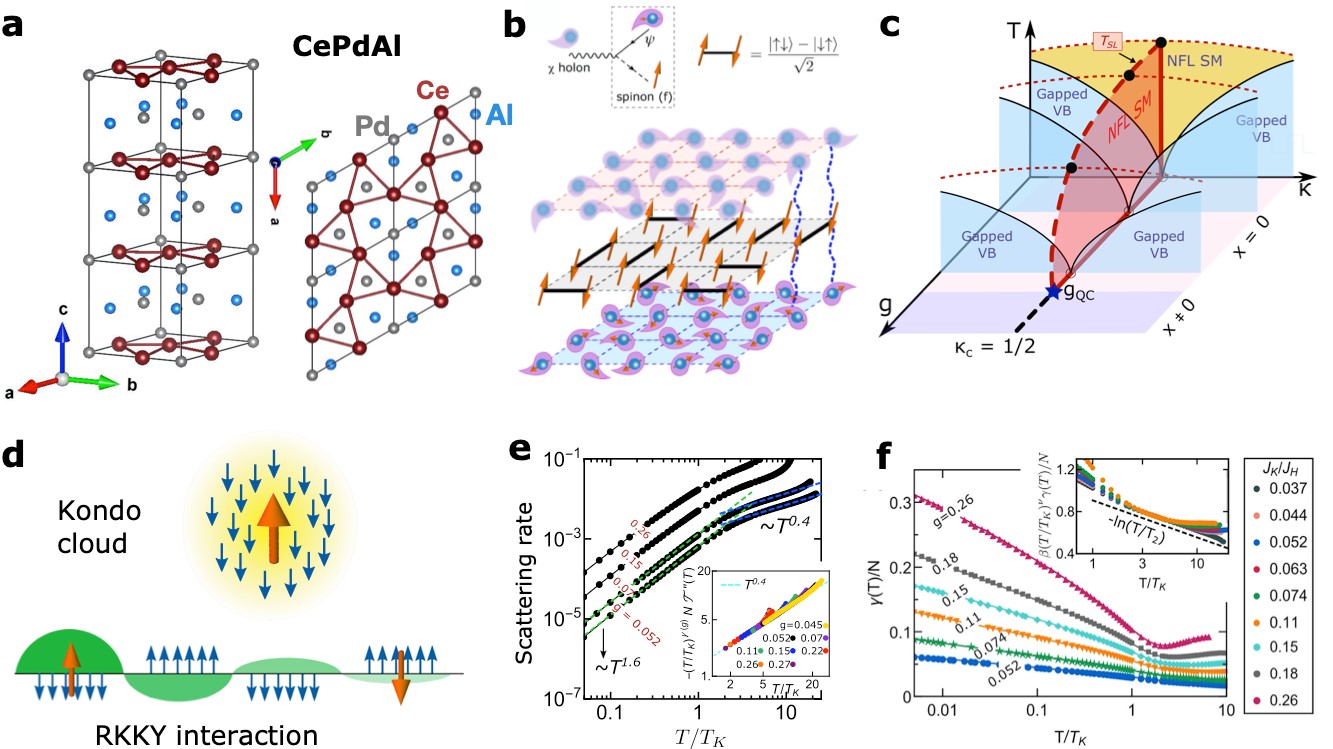A research group led by Prof. Chung-Hou Chung at Department of Electrophysics uncovers a major mystery in condensed matter physics—the mechanism for strange metal phenomena in correlated quantum matter. Their work is published in the prestigious journal “Proceedings of the National Academy of Sciences, PNAS” on March 1, 2022, for the first time for all co-authors being Taiwan-affiliated theoretical physicists.

The research group led by Professor Chung-Hou Chung of the Department of Electrophysics, National Yang Ming Chiao Tung University has achieved a major breakthrough in fundamental research in physics. Together with two postdoctoral researchers, Dr. Jiangfan Wang and Dr. Yung-Yeh Chang, they revealed the mechanism for the strange metal behaviors observed in rare-earth intermetallic compound CePdAl, based on the interplay of the low-temperature quantum-mechanical fluctuations of electron charges and spins [1].
Professor Chung pointed out that in the low-temperature regime where superconductivity has not yet appeared, resistivity of ordinary metals such as copper decreases with the square of the temperature, while the specific heat coefficient remains a temperature independent constant. This phenomenon has been well understood and successfully explained within the “Fermi-liquid theory”, established by a Soviet physicist, Lev Landau in 1956. However, over the past three decades, a growing number of correlated electron systems whose transport and thermodynamic behaviors violated Landau’s Fermi-liquid paradigm, so called “non-Fermi liquid” or “strange metal”. Examples of these strange metal phenomena include the high-temperature cuprate superconductors, iron pnictides, and the rare-earth intermetallic compounds. Typical strange metal behavior includes a logarithmic-in-temperature divergence in electronic specific heat coefficient and a quasi-linear-in-temperature electrical resistivity. Those phenomena usually exist in the quantum critical region caused by the competition between two quantum ground states (phases). The microscopic mechanism behind the strange metal behavior still remains a major puzzle in the condensed matter physics community. Since 2017, Prof. Chung’s group has been developing a new theoretical framework, distinct from the previous approaches, to resolve this puzzle. After several years of effort, they have reached a breakthrough—their theory successfully explains the strange metal phase, an elusive quantum-mechanical ground state, recently observed in a rare-earth intermetallic compound CePdAl (Fig. 1 a) in magnetic fields and pressure [2].
Professor Chung pointed out that, similar to the three well-known phases of water–ice, liquid water, and vapor– quantum-mechanical effect can also give rise to exotic but stable states/phases of matter at low-temperature regime where the quantum-mechanical fluctuations dominates over the thermo-fluctuations. The strange metal state here is an example of a new state of matter due to the quantum-critical fluctuations at zero temperature, also known as “quantum-critical phase”. Addressing this fundamental issue helps us to uncover the mysteries behind the novel state of matter due to quantum mechanical effects. Professor Chung further explained that there are two types of electrons with different electronic properties in the rare-earth intermetallic compounds: the mobile conduction electrons (c-electrons), and the local immobile f-orbital electrons (f-electrons). The emergence of the strange metal phase/state is driven by the competition of two distinct types of antiferromagnetic interactions among these two different electrons near an unstable quantum critical point: one interaction is the antiferromagnetic coupling between c-electron and f-electron (the Kondo effect), while the other is the antiferromagnetically RKKY interaction between two local f-electrons (Fig. 1 d). Meanwhile, due to the geometrical frustration arising from the kagome lattice structure of CePdAl, the RKKY interaction leads to antiferromagnetically short-range order spin-liquid state. Hence, the strange metal state can be understood as a quantum-critical phase due to the interplay of the quantum-mechanical fluctuations of the Kondo effect and the magnetic short-range ordered spin-liquid phase. They further found that the key mechanism is the quantum-mechanical fluctuations of the Kondo effect near the quantum critical point (quantum-critical Kondo fluctuation). This fluctuation features the “spin-charge separation” of an electron; namely, a physical electron is fractionalized into a charge-neutral spinful “spinon”, and a spinless charged “holon”. The microscopic mechanism for strange metal phase is attributed to a holon simultaneously interacting with a spinon (f-electron) and a conduction electron via critical Kondo fluctuation near an unstable quantum critical point (Fig. 1 b). More interestingly, this originally unstable quantum critical state can be stabilized and becomes a stable “quantum-critical phase” when the particle-hole symmetry is preserved (Fig. 1 c). This mechanism successfully explains the existence of the stable quantum-critical phase (the strange metal state) and the strange metal behaviors in electrical resistivity (Fig. 1 e) and specific heat coefficient (Fig. 1 f) observed in CePdAl [2]. The success of this microscopic mechanism proposed by Prof. Chung’s group paves the way to resolve the long-standing puzzle of strange metal phenomena across various correlated electron systems, including the most well-known T-linear resistivity observed in high-Tc cuprate superconductors.

Figure 1: a. Crystal structure of CePdAl. b. Upper left: schematic representation for generating a composite holon (χ): a holon χ is generated by creating a spinon (f, orange arrow) and annihilating a conduction electron (ψ) through the Kondo interaction vertex. Upper right: schematic plot of a RVB spin-singlet bond. Bottom: Schematic plot of the gapless strange metal spin-liquid phase. c. Schematic phase diagram in terms of g, 𝜅, and T of our model, where g = JK/JH is defined as the ratio of the Kondo coupling JK and the Heisenberg coupling JH. d. Schematic representations of the Kondo effect and the RKKY interaction with TK being Kondo scale. e. T-matrix (proportional to electron scattering rate and electrical resistivity) as a function of dimensionless temperature T/TK (TK being the Kondo temperature). Inset shows scaling of T-matrix. f. Specific heat coefficient as a function of T/TK.
- [1] Jiangfan Wang, Yung-Yeh Chang and Chung-Hou Chung, A mechanism for the strange metal phase in rare-earth intermetallic compounds, (PNAS), Volume 119(10) e2116980119 March 1, 2022. DOI: 10.1073/pnas.2116980119 (2022).
[2] H. Zhao et al., Quantum-critical phase from frustrated magnetism in a strongly correlated metal. Nat. Phys. 15, 1261–1266 (2019).